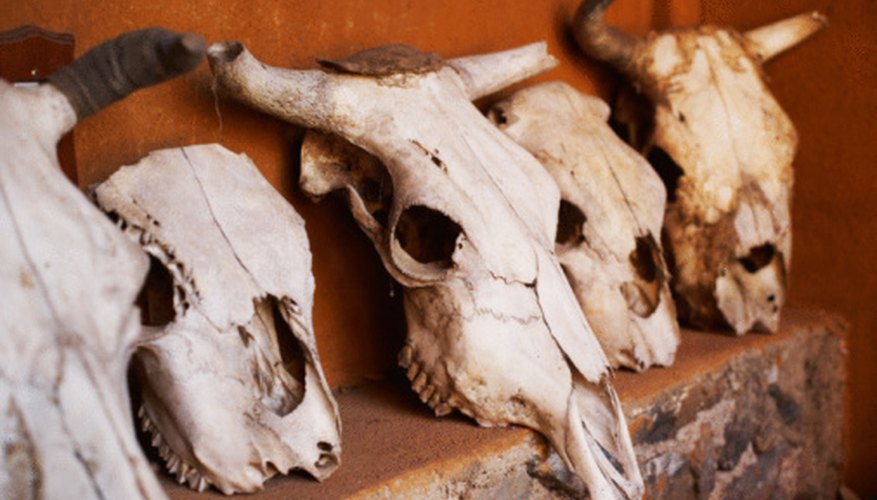
Cleaning a cow skull requires several stages of cleaning. Each stage in the process serves a different purpose toward the end goal. A properly cleaned cow skull should be bright white and free of all organic matter. Improperly cleaned cow skulls tend to get dirty and stink. Visit your local meat processing plant to inquire about purchasing or obtaining a cow skull.
Pre-treatment
Use a scalpel and butcher knife to remove as much of the skin, hair and muscles from the skull as possible. Use the scalpel to cut the tendons and sinew, while using the butcher knife to cut and scrape the tissues away from the skull. Keep the sharp blades away from the actual skull to avoid damaging it.
Gouge the eyes out of the sockets with the scalpel. Scrape any fat deposits off of the skull with the butcher knife. Pry open the jaws of the cow skull with your hands and cut out the tongue. If you see any vertebrae still attached to the skull, cut sinew tissue to remove these. Don't worry about the brain at this point, because the maceration and boiling will remove it for you through liquefaction.
Rinse all blood and loose tissues off the skull into a 5-gallon bucket with a garden hose.
Maceration
Boil the cow skull in a large stew pot for one hour. Turn the stove off at this point and carry the stew pot outside. Let the water cool for a few hours.
Remove the skull from the boiled water and remove any loose flesh that comes away easily with your fingers.
Fill a container large enough to submerge the cow skull with water. Place the cow skull in the container and fill it with water. Take the lid of the container and cut a hole in the center of it with the butcher knife. Cut the hole big enough to fit an electrical cord plug through.
Push the plug on the end of the submersible thermostat-controlled heater through the hole in the lid. Set the thermostat to 95 degrees F. or 35 degrees C.. Put the lid on the container with the thermostat dangling down in the water. Plug the cord into a power outlet and let the skull soak for two days.
Remove the lid and heater from the container. Pour out half of the water and refill the container with fresh water. Replace the lid and allow the skull to soak for up to 14 days. The remaining tissues on the outside and on the inside of the skull will be eaten and cleaned by bacteria thriving in the heated water.
Bleaching the Skull
Scalpel
Butcher knife
5-gallon bucket
Garden hose
Stew pot
Stove range
10 gallon, plastic container with a lid
Submersible, thermostat-controlled heater
Absorbent paper
Dishwashing soap
Measuring cup
Hydrogen peroxide
If you don't want to go through the trouble of macerating the cow skull, you can place the cow skull outdoors during summertime temperature and let fly larvae clean it. Cover the skull with leaves and check on it in a couple weeks.
Dispose of the tissues in accordance with local bio-hazardous waste laws in your municipality. Wear rubber gloves at all times during the process. Always wash hands with an antibacterial soap, after handling any parts of the skull.
Remove the skull from the soaking container. Rinse it clean under running water and place it on absorbent paper at room temperature. Let it dry out for one day. Keep it out of sunlight or it can crack.
Heat water and dishwashing soap in a stew pot until it's simmering hot, but not boiling. Place the skull in the pot and let it cook for an hour. This is done to remove any fat grease from the skull. If the grease remains on the skull, the skull will get dirty and the bleaching process won't work very well.
Mix 6 cups of hydrogen peroxide with 10 gallons of water in the soaking container. Submerge the cow skull in the mixture and let it soak for three days. Remove the heating thermostat form the lid and put the lid on the container. Leave the hole in the lid open to allow the gases to escape.
Check the skull in three days to see if it's as white as you want it. If not, pour out the used solution and refill the container with a new mixture. Repeat the process until you're happy with the results. Allow the cow skull to dry on absorbent towels when finished soaking.
Items you will need
Tips
Warnings
References
Tips
- If you don't want to go through the trouble of macerating the cow skull, you can place the cow skull outdoors during summertime temperature and let fly larvae clean it. Cover the skull with leaves and check on it in a couple weeks.
Warnings
- Dispose of the tissues in accordance with local bio-hazardous waste laws in your municipality.
- Wear rubber gloves at all times during the process.
- Always wash hands with an antibacterial soap, after handling any parts of the skull.



